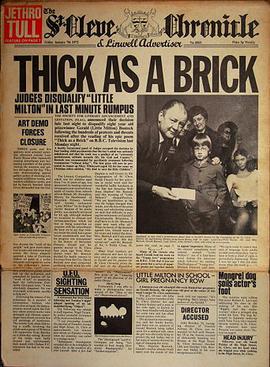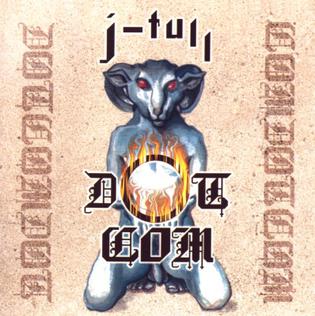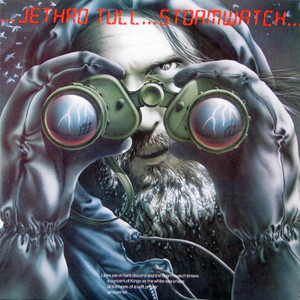Jethro Tull may refer to:
- Jethro Tull (agriculturist) (1674–1741), English agriculturist, often credited with inventing the seed drill
- Jethro Tull (band), a British rock group named after the agriculturist
Jethro Tull may refer to:

Jethro Tull are a British progressive rock band formed in Blackpool, Lancashire, in 1967. Initially playing blues rock and jazz fusion, the band soon incorporated elements of English folk music, hard rock and classical music, forging a signature progressive rock sound. The group's lead vocalist, bandleader, founder, principal composer and only constant member is Ian Anderson, who also plays flute and acoustic guitar. The group has featured a succession of musicians throughout the decades, including significant contributors such as guitarists Mick Abrahams and Martin Barre ; bassists Glenn Cornick, Jeffrey Hammond, John Glascock, Dave Pegg, Jonathan Noyce and David Goodier; drummers Clive Bunker, Barrie "Barriemore" Barlow and Doane Perry; and keyboardists John Evan, Dee Palmer, Peter-John Vettese, Andrew Giddings and John O'Hara.

Jethro Tull was an English agriculturist from Berkshire who helped to bring about the British Agricultural Revolution of the 18th century. He perfected a horse-drawn seed drill in 1701 that economically sowed the seeds in neat rows, and later developed a horse-drawn hoe. Tull's methods were adopted by many landowners and helped to provide the basis for modern agriculture.

Thick as a Brick is the fifth studio album by the British rock band Jethro Tull, released on 3 March 1972. The album contains one continuous piece of music, split over two sides of an LP record, and is intended as a parody of the concept album genre. The original packaging, designed as a 12-page newspaper, claims the album to be a musical adaptation of an epic poem by fictional eight-year-old genius Gerald Bostock, though the lyrics were actually written by the band's frontman, Ian Anderson.

Aqualung, released in March 1971 by Chrysalis Records, is the fourth studio album by the rock band Jethro Tull. Though it is generally regarded as a concept album, featuring a central theme of "the distinction between religion and God", the band have said there was no intention to make a concept album, and that only a few songs have a unifying theme. Aqualung's success signalled a turning point in the career of the band, which went on to become a major radio and touring act.

A Passion Play is the sixth studio album by British progressive rock band Jethro Tull, released in July 1973 in both the UK and US. Following in the same style as the band's previous album Thick as a Brick (1972), A Passion Play is a concept album comprising individual songs arranged into a single continuous piece of music. The album's concept follows the spiritual journey of a recently deceased man in the afterlife, exploring themes of morality, religion and good and evil. The album's accompanying tour was considered the high water mark of Jethro Tull's elaborate stage productions, involving a full performance of the album accompanied by physical props, sketches and projected video.

Too Old to Rock 'n' Roll: Too Young to Die! is the ninth studio album released by British band Jethro Tull, recorded in December 1975 and released in 1976. It is the first album to include bassist John Glascock who also contributes with backing vocals. Too Old to Rock 'n' Roll: Too Young to Die! is the last Jethro Tull concept album, which follows the story of Ray Lomas, an aging rocker who finds fame with the changes of musical trends. It was Jethro Tull's only album of the 1970s not to achieve Gold certification.

Ian Scott Anderson is a British musician best known for his work as the singer, flautist, acoustic guitarist, primary songwriter, and sole continuous member of the rock band Jethro Tull. He is a multi-instrumentalist who also plays harmonica, keyboards, bass guitar, bouzouki, balalaika, saxophone and a variety of whistles. His solo work began with Walk into Light in 1983; since then he has released another five albums, including the sequel to the 1972 Jethro Tull album Thick as a Brick, titled TaaB 2: Whatever Happened to Gerald Bostock? (2012).

J-Tull Dot Com is the 20th studio album by the British band Jethro Tull, released in 1999 on Papillon, the Chrysalis Group's late 1990s heritage record label. It was released four years after their 1995 album Roots to Branches and continues in the same vein, marrying hard rock with Eastern music influences. It is the first album to feature Jonathan Noyce on bass, who would remain with the band until 2007 in Jethro Tull's longest ever unchanged line-up. This was the last Jethro Tull album to feature all original, new material for 23 years, although the band did release a Christmas album in 2003, which contained a mixture of new material, re-recordings of Tull's own suitably themed material and arrangements of traditional Christmas music.

Minstrel in the Gallery is the eighth studio album by British rock band Jethro Tull, released in September 1975. The album sees the band going in a different direction from their previous work War Child (1974), returning to a blend of electric and acoustic songs, in a manner closer to their early 1970s albums such as Benefit (1970), Aqualung (1971) and Thick as a Brick (1972). Making use of a newly constructed mobile recording studio commissioned and constructed specifically for the band, the album was the first Jethro Tull album to be recorded outside of the UK, being recorded in tax exile in Monte Carlo, Monaco.

Stormwatch is the twelfth studio album by progressive rock band Jethro Tull, released in September 1979. The album is often considered the last in a trio of folk rock albums released by the band at the end of the 1970s, alongside Songs from the Wood (1977) and Heavy Horses (1978). The album's themes deal mostly with the environment, climate and seaside living, and were heavily inspired by the Isle of Skye in Scotland, where frontman Ian Anderson had recently purchased property.

Benefit is the third studio album by the British rock band Jethro Tull, released in April 1970. It was the first Tull album to include pianist and organist John Evan – though he was not yet considered a permanent member of the group – and the last to include bass guitarist Glenn Cornick, who was fired from the band upon completion of touring for the album. It was recorded at Morgan Studios, the same studio where the band recorded its previous album Stand Up; however, they experimented with more advanced recording techniques.
Barrie "Barriemore" Barlow is an English musician, best known as the drummer and percussionist for the rock band Jethro Tull, from May 1971 to June 1980.

Under Wraps is the 15th studio album by the band Jethro Tull, released in 1984. The songs' subject matter is heavily influenced by bandleader Ian Anderson's love of espionage fiction. It was controversial among fans of the band due to its electronic/synthesizer-based sound, particularly the use of electronic drums. Dave Pegg has been quoted as saying that the tracks cut from the sessions for Broadsword and the Beast would have made a better album, while Martin Barre has referred to it as one of his personal favourite Tull albums. The album reached No. 76 on the Billboard 200 and No. 18 on the UK Albums Chart. The single "Lap of Luxury" reached No. 30.
"Aqualung" is a song by the British progressive rock band Jethro Tull, and the title track from their Aqualung (1971) album. The song was written by the band's frontman, Ian Anderson, and his then-wife Jennie Franks.

Glenn Douglas Barnard Cornick was an English bass guitarist, best known as the original bassist for the British rock band Jethro Tull from 1967 to 1970. Rolling Stone has called his playing with Tull as "stout, nimble underpinning, the vital half of a blues-ribbed, jazz-fluent rhythm section".
Jethro is a male given name meaning "Friend of God". It is derived from the Hebrew word Yithrô.
Dee Palmer is an English composer, arranger, and keyboardist best known for having been a member of the progressive rock group Jethro Tull from 1976 to 1980.

Thick as a Brick 2, abbreviated TAAB 2 and subtitled Whatever Happened to Gerald Bostock?, is the fifth studio album by Jethro Tull frontman Ian Anderson, released in 2012 as a sequel album to Thick as a Brick, Jethro Tull's 1972 parody concept album. It entered the Billboard chart at No. 55.
Tull is a surname. Notable people with the surname include:

"Teacher" is a song by the British rock band Jethro Tull, first released as the B-side to the January 1970 single "The Witch's Promise", on the Chrysalis label. Written by the band's frontman Ian Anderson, the song is a comment on the corruption of self-styled gurus who used their followers for their own gain.